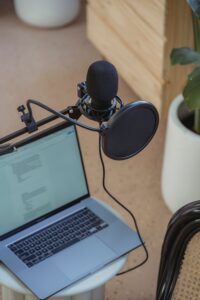
By Philip Bliss
Special to Financial Independence Hub
In the ever-expanding world of podcasting, creating a professional and efficient podcast studio is essential for producing high-quality content that captivates your audience.
Whether you’re a seasoned podcaster or just starting out, building a dedicated podcast studio can elevate your production value and enhance the overall podcasting experience.
In this guide, we’ll walk you through the essential tasks, equipment, and strategies to not only set up your podcast studio but also effectively promote your podcast.
Tasks
- Define Your Niche and Audience:
- Identify your target audience and the niche you want to focus on.
- Research competitors in your niche and understand what sets your podcast apart.
- Create a Content Plan:
- Develop a content calendar outlining topics, guests, and episode release schedule.
- Plan for regular, engaging content to keep your audience coming back.
- Design Your Studio Layout:
- Choose a quiet and dedicated space for your podcast studio.
- Consider acoustic treatment to minimize echo and external noise.
- Invest in Quality Recording and Editing Software:
- Choose reliable recording software like Audacity, GarageBand, or Adobe Audition.
- Invest time in learning the basics of audio editing for polished episodes.

Equipment
- Microphone:
- Invest in a high-quality microphone like the Shure SM7B or Blue Yeti.
- Consider a pop filter and shock mount to enhance audio clarity.
- Headphones:
- Choose closed-back headphones to prevent audio leakage during recording.
- Opt for comfortable and studio-grade headphones like Audio-Technica ATH-M50x.
- Audio Interface:
- Select a reliable audio interface such as Focusrite Scarlett 2i2 for clear audio signal processing.
- Mixing and Monitoring Equipment:
- Include a mixer if you plan to have multiple hosts or guests.
- Invest in studio monitors for accurate sound monitoring.
- Recording Accessories:
- Use a sturdy microphone stand or boom arm for convenience.
- Consider a portable vocal booth or isolation shield for noise reduction.
Promotion Strategies:
- Create a Captivating Podcast Cover Art:
- Design eye-catching cover art that reflects your podcast’s theme.
- Ensure it is visually appealing and easily recognizable.
- Leverage Social Media:
- Utilize platforms like Twitter, Instagram, and Facebook to promote episodes.
- Engage with your audience through polls, questions, and discussions.
- Collaborate with Influencers and Guests:
- Invite influential guests relevant to your niche.
- Cross-promote with other podcasters to expand your reach.
- Optimize for SEO:
- Use relevant keywords in your podcast title, description, and episode titles.
- Submit your podcast to directories like Apple Podcasts, Spotify, and Google Podcasts.
- Consistent Branding Across Platforms:
- Maintain a cohesive brand identity across your podcast, website, and social media.
- Use the same logo, color scheme, and tone of voice to establish brand recognition.
Building a successful podcast studio involves a combination of careful planning, quality equipment, and effective promotion. By following these tasks, investing in the right equipment, and implementing promotion strategies, you’ll be well on your way to creating a podcast that not only sounds professional but also reaches a wider and more engaged audience. Remember, consistency and dedication are key in the world of podcasting, so stay committed to delivering valuable content to your listeners. Good luck on your podcasting journey!
 Philip Bliss is founder and CEO of Canada’s Podcast. Philip is a business visionary, entrepreneur, digital marketing pioneer and a board-level executive. He provides strategy, marketing, product and technology leadership to companies and organizations. Philip has built and sold four companies and been a strategic advisor, marketing visionary, product marketer and board-level director to a number of start-ups and major names in the technology, real estate and travel sectors. He has been instrumental in the branding and marketing launch of many consumer software products.
Philip Bliss is founder and CEO of Canada’s Podcast. Philip is a business visionary, entrepreneur, digital marketing pioneer and a board-level executive. He provides strategy, marketing, product and technology leadership to companies and organizations. Philip has built and sold four companies and been a strategic advisor, marketing visionary, product marketer and board-level director to a number of start-ups and major names in the technology, real estate and travel sectors. He has been instrumental in the branding and marketing launch of many consumer software products.
Disclaimer: This article was AI Assisted via ChatGPT.


